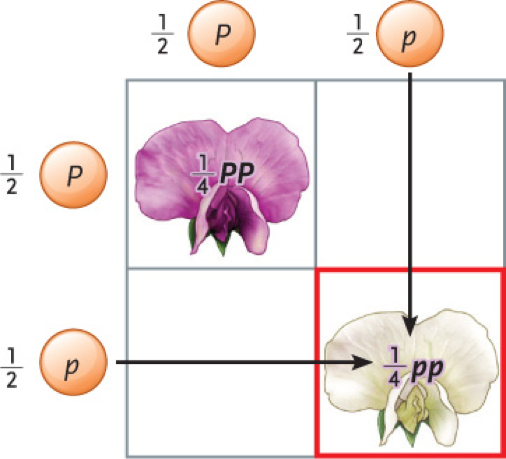Cycle 5
Gregor Mendel
- most important innovation was his quantitative approach to science, specifically his rigour and statistical analysis
- careful experimentation using controlled crosses and quantitative analysis
Explanatory Model
- variation in traits are due to different alleles
- organisms inherit 2 alleles for each trait (one from each parent)
- phenotype determined by dominant allele
- frequency of alleles in determined by selection not dominance (dominant alleles aren’t always the best suited to the environment)
- offspring are not a mix of both their parents
- Principle of Segregation: two alleles of a gene segregate from each other in gamete formation (one allele on each chromosome)
- Principe of Independent Assortment: During the segregation of alleles into gametes, the alleles of the different pairs assort independently (randomly line up along the metaphase
 plate)
plate)
Monohybrid cross: cross that involves 1 character (3:1 phenotypic ratio)
- creates 2 gametes: Rr x Rr = R, r
Dihybrid cross: cross involving 2 characters (9:3:3:1 phenotypic ratio)
- 9: R_Y_, 3: R_yy, 3: rrY_, 1: rryy
- creates 4 gametes: RrYy x RrYy = RY, Ry, rY, ry
Testcross: cross involving 1 homozygous recessive parent and another unknown parent, determines whether the genotype of the 2nd parent is heterozygous or homozygous
Sex Linked Genes (Reciprocal cross): inherited differently in males and females.
- only males get the Y chromosome
- Sex linked traits are not carried on the Y chromosomes
Locus (loci): particular site on a chromosome at which a gene is located
Alleles: multiple forms of a gene
- different alleles consist of small differences in the DNA sequence of a gene, which result in functional differences in the protein or RNA product encoded by the gene. These differences are detected as distinct phenotypes in the offspring of a cross
- may differ due to SNPs, CNVs, indel’s… various mutations
Sum Rule: the probability that either event A or event B will occur, add the fractions![]()
Product Rule: the probability that events A and B both will occur, multiply the fractions
Epistasis
- genes interact with alleles at one locus inhibiting the effects of alleles at a different locus
- The result is that some expected phenotypes do not appear among offspring
- ex. Black, brown & yellow dogs -homozygotes recessive for e don’t show any pigment
Codominance occurs when alleles have approximately equal effects in individuals, making the two alleles equally detectable in heterozygotes, both phenotypes are expressed
Incomplete dominance occurs when the effects of recessive alleles can be detected to some extent in heterozygotes, when one allele is not completely dominant to the other, we use a superscript to signify the character: the colours are BLENDED![]()
Polygenic Traits: many different genes contribute to the same character
Pleiotropic Genes: single genes affecting more than one character of an organism
Quantitative traits: a character that displays a continuous distribution of the phenotype involved (bell curve)
X-linked inactivation
- females with two X chromosomes inactivate most of the genes on one X chromosome or the other in most body cells
- once one of the X chromosomes is inactivated in a cell, that same X is inactivated in all descendants of the cell. Thus, within one female, one of the X chromosomes is active in particular cells and inactive in others, and vice versa
- similar to a mosaic